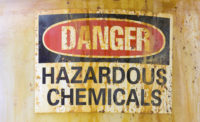One year after OSHA’s June 1st, 2016 “Globally Harmonized System” (GHS) label end user deadline, more than one out of five companies had not yet met all requirements, according to a new survey.
That said, tools and strategies exist to help small to mid-sized companies achieve GHS label compliance rather quickly and inexpensively. With higher OSHA penalties making non-compliance more costly, using such tools and attaining compliance is a priority.
“The OSHA GHS label deadline for end users has come and gone, and it is now a costly compliance issue,” says Christine Webb, CSP, a consultant at Avitus Group, a U.S. based provider of services that allow small companies to strengthen and grow their businesses. Some of these services include safety, compliance, training, payroll, and more.
According to Webb, a former OSHA compliance officer, last year Congress enacted a bill that allowed federal agencies to raise their fines, which have not been updated in decades.
“OSHA increased its fines by 78 percent, so a more severe citation that could cost up to $7,000 previously can now cost over $12,000,” says Webb. “Not having appropriate GHS labels on secondary containers is one of the easiest compliance issues to spot and cite.”
In an industrial facility, chemical formulations that could require GHS labeling range from industrial primers, coatings, and sealants to lubricants, greases, cutting oils, and rust removers to acid, alkaline, and solvent based cleaners to degreasers, surfactants, disinfectants, and sanitizers.
Barriers to compliance
1) GHS Label content
Finding and placing compliant GHS content onto the label has been the most challenging part of the labeling process. Tracking down updated safety data sheets, determining the key data, and printing it on the GHS label in the correct format, which requires GHS pictograms, has proven problematic.
On each GHS label, six specific items of data are required: Product Name or Identifier; Hazard Statement; Signal Word; GHS Pictogram symbols; Precautionary Statement; and Supplier Information. In place of the familiar black and white pictogram symbols previously used, GHS labels require pictogram symbols that convey hazard information with a red diamond border.
“A lot of people still don’t fully understand GHS labeling requirements, particularly at the small to mid-sized company level,” says Webb.
Webb often shows clients how to use free GHS label software available online and how to print labels from desktop printers.
She says that such GHS label software is intuitive, like using an app or a Microsoft Word template.
Crucial GHS label data can be accessed almost instantly from online databases and formatted to GHS requirements. Much of the necessary information can be obtained, in fact, by simply entering a substance’s Chemical Abstracts Service (CAS) number.
“GHS label chemical info can be found on some label company websites,” says Webb. “My clients save it on their PCs, so they don’t have to go back online. They print GHS labels from desktop printers, and put the labels on containers as needed.”
Software can include pictograms and compliant statements needed for GHS labeling, allow customizable text, and insertion of company logo or other images.
No download is required for cloud-based GHS software. It operates from the label company website, and GHS, HMIS, and NFPA labels can be securely saved online or to a computer.
2) GHS label durability
Another challenge is finding durable labels that can withstand chemicals and harsh environments.
Some people mistakenly try to use regular office-grade labels for GHS applications, but find the labels peel or the ink fades in tough workplace settings, according to Webb.
“GHS labels must be durable to stay compliant,” says Webb. “In machine shops and auto body shops, for instance, the labels must resist oil, grease, and solvents, and in restaurants and kitchens hold up to harsh cleansers and disinfectants. In such applications, GHS labels can withstand solvents, degreasers, cleansers as well as abrasion and moisture.”
Durable synthetic labels are chemical resistant, tear resistant, abrasion resistant, and constructed with a high-performance adhesive that is waterproof and passes a 90-day seawater submersion adhesion test.
Unlike typical labels, which crack and harden in harsh conditions, durably synthetic labels are UV resistant with two-plus years of outdoor UV life. They are also temperature resistant, can be applied as low as 10° F, with adhesive service temperatures that can range between -40° F to as high as 300° F.
For extra protection in harsh environments, Webb likes to use an additional laminate over the top of GHS labels. Some label companies offer such labels with a clear laminate so no lamination machine or additional layer of tape is needed. The material is UV and water resistant, and resists scuffing, tearing and smudging, making them ideal for use in warehouses, storage areas and worksites.
3) GHS label size
Some facilities have trouble finding labels that fit their containers.
For end users, GHS compliance is required for chemical formulations purchased in bulk containers for cost savings, such as barrels of industrial cleaner that are transferred to smaller “down-packed” containers, such as spray bottles, for portable use.
Containers requiring GHS-compliant labeling can vary in size from 55-gallon drums down to small test vials.
“Getting correctly-sized GHS labels can be a challenge,” says Webb. “With GHS labels, you usually don’t want labels of only one size or type, not when you could have a dozen or more different types of containers. For my clients, I look to well-known label companies that offer the widest range of GHS label sizes and types.”
Such GHS labels are available in a full range of sizes to fit drums, totes, pails, cans, jugs, containers, and even small bottles. They can be applied to a variety of surfaces such as metal, plastic, glass, ceramic, polycarbonate, painted surfaces, and more.
“Even if you are an end user at a small or mid-sized company, compliance is easier than you think with easy to use GHS label software and labels that you print at your desk,” says Webb. “You can get in compliance quickly, avoid higher OSHA penalties, and keep your employees and workplace safe and productive.”



